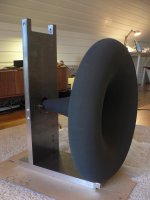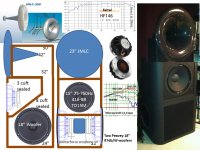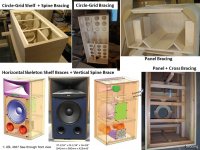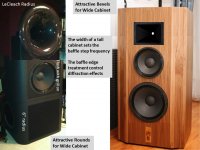A complete Faital build would be awesome I'm thinking the 140 as well and it claims it will go down to 900hz.
Note that 900Hz is only correct when you use a horn with 90deg dispersion.
A narrower dispersion would ideally want a higher crossover point to keep the transition smooth.
That said a sudden, limited narrowing is nowhere near as bad as a sudden widening like you would get with a dome tweeter.
Lastly I have no idea how to calculate beaming beyond 90deg but it is largely predictable as it is mostly a geometric problem if you disregard cone break up and very minor influences from cone shape.
In the end it is a compromise: The higher you run the 15s the more of the midrange will be muddled a bit due to intermodulation (hence my preference of 3ways) , the lower you put the more you stress the compression driver. In conclusion I'd be tempted to forego an idealized dispersion in favour of not running the 15 higher than 900Hz if cd and horn can handle it.
PS: Don't know what the 18Sound ND3 costs in North America but here it goes for £275 or the same as another 18Sound cd which costs US$400 in the States.
Last edited:
Check out the 18 Sound ND3ST on Test Bench. Looks even better....very reasonable price as well.
Test Bench: Eighteen Sound ND3ST 1.4” Compression Driver
George
The Faital HF146 has a Ketone polymer dome, plus a new shorter phase plug, which produce a smoother high frequency response than the titanium dome on the Faital HF140. Compare the SPL graphs, and the Impedance graphs for resonance bumps. The Faital LTH142 is a well reviewed aluminum tractrix horn which perfectly matches the exit angle of Faital compression drivers.
So you have 1.4" CD choices for an all Faital system. See my post #5 for a few cabinet shapes.
With DSP and Bi-Amps for the woofer and tweeter you do not need to put a passive attenuator on the 109db SPL compression driver, but you might find it desirable to balance the large 109db vs 97db difference in efficiency - the large difference in low listening level amplifier power. You will want to study crossover options for the HF146/HF140 compression driver to understand why some designs use resistor L-pads and some designs use multi-tap transformers for attenuation. The HF CD will also require treble boost at 15Khz to get a flat, extended SPL.
There are a few threads on building non-resonant cabinets with the best dimensions for 2-way horn designs.
So you have 1.4" CD choices for an all Faital system. See my post #5 for a few cabinet shapes.
With DSP and Bi-Amps for the woofer and tweeter you do not need to put a passive attenuator on the 109db SPL compression driver, but you might find it desirable to balance the large 109db vs 97db difference in efficiency - the large difference in low listening level amplifier power. You will want to study crossover options for the HF146/HF140 compression driver to understand why some designs use resistor L-pads and some designs use multi-tap transformers for attenuation. The HF CD will also require treble boost at 15Khz to get a flat, extended SPL.
There are a few threads on building non-resonant cabinets with the best dimensions for 2-way horn designs.
Hello!
I do not know what his needs are, but in the choice of drivers keep in mind the nature of the diaphragm, each type has its own sound shadow ... try to listen to at least some of them to figure out which one will best meet his expectations. I think it should pay attention to the sensitivity between CD and WO, the smaller the difference between them will be the corrections and the consequent acoustic alterations, especially if the crossover will be passive. I hope I have been of help, greetings.
Mleod
I do not know what his needs are, but in the choice of drivers keep in mind the nature of the diaphragm, each type has its own sound shadow ... try to listen to at least some of them to figure out which one will best meet his expectations. I think it should pay attention to the sensitivity between CD and WO, the smaller the difference between them will be the corrections and the consequent acoustic alterations, especially if the crossover will be passive. I hope I have been of help, greetings.
Mleod
no mention of geddes Suma yet? GedLee LLC
woodworking for the OS waveguide could be done at a 'maker space' with a CNC router
in fact only the 1st few inches of throat/mating with the CD differ meaningfully from a straight 90 degree cone
http://www.diyaudio.com/forums/multi-way/305973-budget-3000e.html#post5038036
woodworking for the OS waveguide could be done at a 'maker space' with a CNC router
in fact only the 1st few inches of throat/mating with the CD differ meaningfully from a straight 90 degree cone
http://www.diyaudio.com/forums/multi-way/305973-budget-3000e.html#post5038036
The 23" diameter JMLC-350 horn has STYLE.
Attachments
Very true Mleod, thats why Im after titanium. That 3000e is above my skill level, unfortunately.
Im at a point right now that Im not sure what to do, so im going to hopefully start construction on the cabinet next week. I have abandoned the JBL L300 look. I have found that the slop of the front baffle can affect the response, dont need to add any complications. I still want to keep the front baffle wide as to minimize defraction especially at crossover region.
Im going to read through this thread agian from the beginning and take notes of the many suggestions, its a lot of awesome information just need to keep track.
Im at a point right now that Im not sure what to do, so im going to hopefully start construction on the cabinet next week. I have abandoned the JBL L300 look. I have found that the slop of the front baffle can affect the response, dont need to add any complications. I still want to keep the front baffle wide as to minimize defraction especially at crossover region.
Im going to read through this thread agian from the beginning and take notes of the many suggestions, its a lot of awesome information just need to keep track.
BRACE YOURSELF!!
-For your 2-way cabinet, two horizontal shelf braces plus one vertical brace should work well.
-For the JBL 4367 cabinet, the top shelf brace also supports the CD motor and the bottom shelf brace also supports the woofer motor.
-For DIY, low cost circle cutters have made hole-grid arrays more popular than custom cut frame braces.
-Old school used 1" x 1" hard wood strips for top-to-bottom panel bracing plus modest cross bracing. Still popular for DIY = simple + modest cost + high air flow.
BEVELS AND ROUNDS
-For tall cabinets, the width sets the baffle step frequency.
-Bevels and rounds on the baffle edges control diffraction effects.
-Will you place your speakers near the walls, or into the room?
-For your 2-way cabinet, two horizontal shelf braces plus one vertical brace should work well.
-For the JBL 4367 cabinet, the top shelf brace also supports the CD motor and the bottom shelf brace also supports the woofer motor.
-For DIY, low cost circle cutters have made hole-grid arrays more popular than custom cut frame braces.
-Old school used 1" x 1" hard wood strips for top-to-bottom panel bracing plus modest cross bracing. Still popular for DIY = simple + modest cost + high air flow.
BEVELS AND ROUNDS
-For tall cabinets, the width sets the baffle step frequency.
-Bevels and rounds on the baffle edges control diffraction effects.
-Will you place your speakers near the walls, or into the room?
Attachments
The speakers themselves tight now will be against a wall but after I move then who knows.
Cant agree more it will be heavily braced! I have 3/4" MDF/hardwood for the outside and will add 2x4'S for bracing because I have a lot of them left from refinishing a basement, so Ill be using a lot of them, with also keeping in mind air travel and volume of course. I'm going to try and buy a router so I can round edges and countersink. I will also offset the tweeter and mid if used from the woofer. Felt was brought up some time ago and will experiment with that to help reduce diffraction after its built.
If I understand correctly, the issues with baffle step can be corrected in the crossover/DSP by lowering the effected frequency's?
That speaker to the far right looks fantastic!
Cant agree more it will be heavily braced! I have 3/4" MDF/hardwood for the outside and will add 2x4'S for bracing because I have a lot of them left from refinishing a basement, so Ill be using a lot of them, with also keeping in mind air travel and volume of course. I'm going to try and buy a router so I can round edges and countersink. I will also offset the tweeter and mid if used from the woofer. Felt was brought up some time ago and will experiment with that to help reduce diffraction after its built.
If I understand correctly, the issues with baffle step can be corrected in the crossover/DSP by lowering the effected frequency's?
That speaker to the far right looks fantastic!
- Status
- This old topic is closed. If you want to reopen this topic, contact a moderator using the "Report Post" button.
- Home
- Loudspeakers
- Multi-Way
- 15" 2-way Ideas



